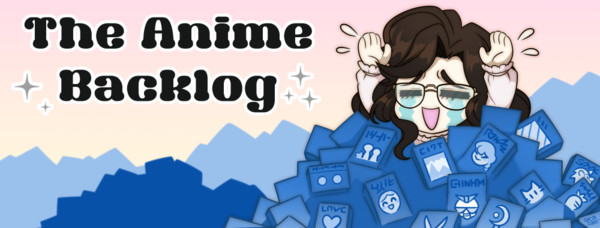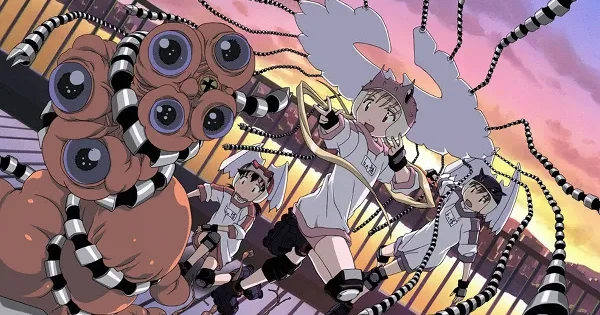Curated From www.animenewsnetwork.com Check Them Out For More Content.

Thank you everyone for patiently tuning in to another edition of The Anime Backlog. As you can guess, last week (and three weeks leading up to it) was one the busiest for me while I coordinated Anime Expo coverage. You can expect two editions of The Anime Backlog this month; you can forgive me if I specifically target long-overdue OAVs and movies until things chill out this summer. I’ll be heading to both Otakon and Anime NYC before the season is out!
This week, I dusted off a physical release that’s sat on my shelf for several years after buying it on a whim—Alien 9.
Note: This column will routinely include spoilers. Reader discretion is advised.

©2001 Hitoshi Tomizawa, Akita Shoten/’Alien 9′ Committee.
Alien 9
Why Is It Important?
Alien 9 was a four-episode intermittent television broadcast; we have it classified as a “special” in the ANN Encyclopedia, but it might be more apt to call it an OAV that aired on television instead of going straight to video. Debuting in 2001, Alien 9 is a special kind of weird in an era when less was more and challenging your audience was par for the course. Narratively, the story is often compared to Neon Genesis Evangelion on blogs, but it’s not quite operating on that level; Evangelion is just used as shorthand for “mindfuck” anime, and Alien 9 plays in that same sandbox.
At about 100 minutes, the anime features early career work for what are now well-established creatives in the industry. Fullmetal Alchemist: Brotherhood director Yasuhiro Irie helmed episodes 2-4 before leading several projects at BONES. Sadayuki Murai wrote two episode scripts before later penning Kino’s Journey, several seasons of Natsume’s Book of Friends, and multiple projects at Polygon Pictures. I wouldn’t go as far as to credit Alien 9 for launching several staff members’ careers, but it is an interesting peek at their directorial and storywriting styles prior to “hitting it big.”
I mentioned that Alien 9 slots into a period when anime, especially OAVs, were more esoteric. There are a number of projects from this period that simply don’t conclude and are less interested in spelling out narrative beats for the audience. Less than Evangelion, Alien 9 more closely resembles Boogiepop Phantom (Murai was head of the series composition) that premiered a year earlier, or the ’90s Shamanic Princess. What’s going on? Figure it out yourself.
At a baseline, Alien 9 is about three sixth-graders assigned to the “Alien Party,” a committee responsible for rounding up aliens on campus. It’s treated like any other assigned class responsibility but requires the three girls to wear a symbiotic alien called a “Borg” on their head while confronting a variety of aliens with differing levels of aggression. Crybaby Yuri is the primary point of view, but we get some insight from the responsible leader-type Kumi and high-achiever Kasumi.
There’s also a very strong throughline about puberty and adolescent fear of body development.
Does It Live Up to Its Reputation?
Alien 9 typically gets high praise around the internet for its unexpected tonal swerve. The character designs, and even the general mood and plot, have a proto-Madoka feel. There isn’t any cross-over between the staff, but similar to Gen Urobuchi and SHAFT‘s original magical series, Alien 9 features very round, moe-invoking designs that belie gory action sequences and 12-year-old girls frequently crying for their mommies. If you’ve been around the block a few times, you’ve seen gorier and probably watched more emotionally distressing series, but to put it in modern terms: Alien 9 pulled a School-Live! about 15 years before anyone knew what that meant. This isn’t a case of “I heard of this before you,” but a matter of contextualizing why people talked about this four-episode OAV well past its expiration date.
And it certainly is weird. Beyond the visual of girls on rollerblades with winged frogs on their heads, Alien 9 dabbles in adolescent body horror, specifically through the lens of Yuri. As a character, Yuri is a tough sell. Any frustration borne out of the “get in the robot, Shinji” meme would be tripled when confronted with Yuri. She cries when confronted with the disgusting nature of her new job; she cries when friends come to her birthday party, and she cries at the prospect of doing anything heroic. Yuri never grows beyond the first episode, and viewers will understandably be frustrated with her and how her helplessness puts the other members at risk. This would be a central character arc in a longer series, but Alien 9‘s limited run time only allows it to telegraph so much to the audience.
Still, the team does an exemplary job of laying the groundwork for Yuri’s anxieties centered around puberty. There is considerable overt framing throughout the OAV, from the health class measurements to the psychedelic borgs singing about adulthood to Yuri’s swimsuit choice during summer break. The girl is in a state of arrested development that never resolves by the time the credits close. Meanwhile, we only get shadowy outlines of Kumi and Kasumi’s internal struggles and vague ideas about the larger conspiratorial plot taking place in the background. Sadly, the original manga is out of print, and some of its sequels have never made it stateside, but a quick browse of Alien 9‘s Wikipedia article will give you all the information you need to resolve those loose ends.
Watch It or Remove It?
The OAV pulls off some genuinely freaky imagery throughout its run and is enjoyable as a proto-work. The first episode on my 2005-era DVD copy is a little rough, with obvious interlacing issues. Additionally, any viewers going in should know that there is no conclusive arc and certain elements will never be adequately addressed. Alien 9 is best approached as a curiosity, but if what I’ve written above hasn’t piqued yours, there’s no harm in skipping it.
Final Verdict: Unless I’ve successfully sold you on it, skip it.
Title: Alien 9 Media Type:OAV Length: 4 episodes Vintage: 2001-2002 Genres: Sci-fi, Horror, Psychological Availability
|

